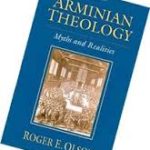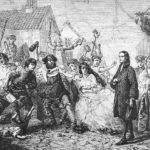Sometime ago James White, a well-known champion for Calvinists, addressed 2 Peter 2:1, offering an explanation of the text that would not undermine the doctrine of Limited/Particular Atonement.
I will address each of the major points he makes in the following recording: https://youtu.be/hPFTTxNEkvk?si=PES8nf9Hg0BJJoHC.
First, White begins his argument by assuming the validity of the doctrine of Limited/Particular Atonement, claiming that its effects and results are clearly evident in Hebrews 7, 9, and 10. In examining these chapters, it becomes apparent White refers to the effects and results of the doctrine because a basis for the doctrine is not established in these chapters. He reads the doctrine into the text as though he were serving a systematic conclusion in search of a text.
What does the author of Hebrews say about the extent of the atonement? Notice the universal language (not to be confused with universalism!) used in Hebrews 2:8-11:
“‘putting everything [panta] in subjection under his feet.’ Now in putting everything [panta] in subjection to him, he left nothing [ouden] outside his control. At present, we do not yet see everything [panta] in subjection to him. But we see him who for a little while was made lower than the angels, namely Jesus, crowned with glory and honor because of the suffering of death, so that by the grace of God he might taste death for everyone [panta]. For it was fitting that he, for whom [lit. “all things exist,” panta] and by whom all things exist [panta], in bringing many sons to glory, should make the founder of their salvation perfect through suffering. For he who sanctifies and those who are sanctified all [pantes] have one source. That is why he is not ashamed to call them brothers.”
While we do not see everything in subjection to Christ now, is there anything that will not be subjected to him? No. Is there anything outside of his control? No. All things without exception will be put in subjection to him.
Is there anything that exists apart from Christ? No. All things without exception exist by his power and for his glory.
Do Christ and believers have a different divine source? No. All of God’s children without exception have God as their source, both Christ and his sanctified brothers.
The author of Hebrews is using panta in this passage in a consistent manner to refer to all without exception, not all without distinction.
Thus, is there anyone for whom Christ did not taste death on behalf of? No. He tasted death for all people without exception (cf. Heb 9:15). Christ did not suffer and die to taste death only for a limited/particular group of people, the elect or new covenant believers. Rather, Christ suffered and tasted death for everyone.
To claim that Christ’s death for everyone is limited to believers only, or the many sons brought to glory in Hebrews 2:10, is to disregard the fact that the three occurrences of panta immediately before and the two occurrences of panta immediately after the statement that “he might taste death for everyone [panta]” each unambiguously refer to all without exception. There is no exegetical basis for restricting panta in this passage.
The doctrine of Limited/Particular Atonement is explicitly denied in Hebrews 2:8-10. Interestingly enough, White begins his explanation of 2 Peter 2:1 by appealing to the effects and results of Limited/Particular Atonement, which he imposes onto Hebrews 7, 9, and 10 so as to prevent people from being mislead into believing what the text clearly seems to be saying.
Second, the doctrine of Limited/Particular Atonement has no leg to stand on if “denying the Master who bought them” (2 Pt 2:1) refers to Jesus’ sacrificial payment on the cross. Consequently, White notes that in other texts “Master” (despotēs) refers to God the Father and does not always by default refer to Jesus. Of course that is true. “Master” does not require the same referent in every text.
While “Master/master” (despotēs ) can refer to God the Father (Lk 2:29; Acts 4:24; 2 Tim 2:21; Rev 6:10) or to human masters (1 Tim 6:1, 2; Tit 2:9; 1 Pt 2:18), similar to 2 Peter 2:1 the false teachers in Jude 4 “deny our only Master and Lord, Jesus Christ.”
Third, White argues that when “bought” (agorazō) is used in redemptive texts it is always modified by “with a price” (1 Cor 6:20; 7:23) or “by your blood” (Rev 5:9). Since neither phrase modifies “even denying the Master who bought them” in 2 Peter 2:1, then, he claims, if it referred to Jesus it would be the only exception in the New Testament.
Conveniently, he neglects Revelation 14:3-4 where “bought” (agorazō) is clearly employed in a redemptive manner without such a phrase modifying it (cf. Christ as the sacrificial Lamb).
Fourth, whereas White assumes that since “denying the Master who bought them” is not modified by “with a price” or “by his blood” then the concept is likely absent, it could be argued that Peter would naturally expect his audience to read his statement to mean “even denying the Master who bought them with a price” or “even denying the Master who bought them by his blood.” Nothing in 2 Peter suggests otherwise. In fact, Peter states that it is “with the precious blood of Christ, like that of a lamb without blemish or spot” that people are ransomed from their futile ways (1 Peter 1:18-19).
Fifth, White appeals to Gary Long’s interpretation that “denying the Master who bought them” refers to the false teachers denying God the Father who sovereignly placed them in positions of authority that they used to spread false teachings, and because they betrayed the trust of the church, they now deserve swift destruction.
Without an any explanation given by White, one is left to wonder not only how “denying the Master who bought them” refers to the false teachers being sovereignly placed in positions of authority, but also how God the Father bought the false teachers apart from Christ’s sacrificial payment for them on the cross.
An online article from Long unpacks this view further (https://www.the-highway.com/2Pet2.1.html). Long proposes that Peter intentionally alludes to Deuteronomy 32:6 in the Septuagint, which reads, “Do ye thus recompense the Lord [kyrios]? people thus foolish and unwise? did not he himself thy father purchase [ktáomai] thee, and make thee, and form thee?”
Peter uses “bought” (agorazō), according to Long, as an allusive summary for “purchase,” “make,” and “form” “to stress the idea of creating and acquiring Israel as a covenant nation,” including the creation of the false teachers as part of the covenant nation.
What in 2 Peter 2:1-3 in particular indicates that Peter is making any allusion to Deuteronomy 32:6? If Peter wanted to make an explicit reference, he would have likely utilized the same terms (kyrios, ktáomai), but instead he employed different terms (despotēs, agorazō). Furthermore, Deuteronomy 32:6 is not about false prophets, but about the defiance of the nation of Israel before their Creator. Neither the topic nor the vocabulary in either passage are undeniably connected.
Sixth and perhaps most importantly, eighteen of the twenty-five verses in the letter of Jude are parallel with 2 Peter. Many commentators have demonstrated how Peter is elaborating on Jude, a point which White neglects altogether.
Notice the lexical and thematic connections between the two passages.
Jude states:
“Beloved, although I was very eager to write to you about our common salvation, I found it necessary to write appealing to you to contend for the faith that was once for all delivered to the saints. For certain people [false teachers] have crept in unnoticed who long ago were designated for this condemnation [krima], ungodly people, who pervert the grace of our God into sensuality and deny [arneomai] our only Master [despotēs] and Lord, Jesus Christ” (Jude 3-4).
Peter elaborates on the teaching of Jude:
“But false prophets also arose among the people, just as there will be false teachers among you, who will secretly bring in destructive heresies, even denying [arneomai] the Master [despotēs] who bought them, bringing upon themselves swift destruction. And many will follow their sensuality, and because of them the way of truth will be blasphemed. And in their greed they will exploit you with false words. Their condemnation [krima] from long ago is not idle, and their destruction is not asleep” (2 Peter 2:1-3).
The thematic and linguistic connections (arneomai, despotēs, krima) are undeniable between the two texts. This, along with the appositional function of “and” (kai) in Jude 4 to clarify that “our only Master” is “the Lord, Jesus Christ,” makes Jesus the clear referent to Master in 2 Peter 2:1 as he is in Jude 4.
Thus, when the false teachers “deny our only Master and Lord, Jesus Christ” (Jude 4) they are “even denying the Master who bought them, bringing upon themselves swift destruction” (2 Pt 2:1).
The false teachers, who secretly creep into the church pretending to have faith in Christ, deny the Master who paid the price to set them free from their slavery to sin, making their destruction an imminent and swift destruction (cf. 2 Pt 2:19-22). Such ungodly people, presumably along with all who deny Christ, are designated for condemnation from long ago.
Seventh, “the Master who bought them” evokes the image of a slavery. Peter describes himself as a “slave” of Jesus Christ (2 Pt 1:1) and the false teachers as “slaves of corruption” (2:19). Peter is not describing his audience as a congregation of literal slaves any more than he is describing himself as a literal slave. Rather, whereas he is a slave to his only Master and Lord, Jesus Christ, the false teachers are slaves to immorality, denying their Master who bought them to set them free from their enslavement to sin (cf. John 8:34; Rom 6:17, 19).
Claiming “Master” refers to God the Father as the sovereign Creator (Acts 4:24, 29) and “bought” means the Father created the false teachers whom they deny (Dt 32:6) is to prevent the Master/slave relationship of Peter and Jesus (2 Pt 1:1) along with the spiritual enslavement of the false teachers (2:19) to inform our understanding of 2 Peter 2:1. The immediate context of 2 Peter ought to shape our exegesis, not an unlikely interpretation imposed onto the text in order to preserve a systematic theology.
Eighth, that the false teachers deserve swift destruction and eternal condemnation for denying the Master who purchased them buttresses the view that “bought” refers to the sacrificial payment Christ made on the cross for all of mankind. It is a stretch to argue, as White does, that the false teachers deserve swift destruction simply because they betrayed the trust of the church. Is it not more plausible that they deserve swift destruction and eternal condemnation for denying the Lord Jesus Christ who paid the price for their sins with his shed blood on the cross (2 Pt 2:1) alongside denying his second coming and the future judgement (3:3-9)?
Ninth, while his transfiguration is recounted in 2 Peter 1:16-18 and his second coming is anticipated in 3:8-9, Christ’s death naturally stands at the center of these events and is referred to in 2:1.
Tenth, not all who are bought by the Master will be saved. Those with faith are saved. Those who reject Christ are condemned. Christ died for the sins of the whole world (see 1 John 2:1-2; John 1:29; 3:14-18; Rom 5:18-19; 2 Cor 5:14-21; 1 Tim 2:1-6; 4:10; Tit 2:11-14; Heb 2:9; cf. Isa 53:6; Mk 10:45; Heb 9:28). Thus, the atonement is provisional until it is applied, and only on the condition of faith can it be applied whereby it becomes efficacious. As Leroy Forelines noted, “The only way to deny the provisionary nature of [the] atonement is to consider all people for whom Christ died to be justified before they experience faith” (Classical Arminianism: A Theology of Salvation, edited by Matthew Pinson, [Nashville, Randall House Publications, 2011], p. 234).
Eleventh, either the false teachers repudiated Christ who died for them and forfeited their redeemed status (2 Pt 1:10-11; 2:20-22; 3:17; cf. Heb 6:4-6, 9-10), or, as I am inclined to believe, the false teachers had a false faith to begin with and secretly brought in destructive heresies denying the Master who paid the price to set all people free from their slavery to sin (1 Pt 1:3-5; 2 Pt 2:19; Jude 1, 24-25; 1 John 2:18-20).
Finally, it seems clear, based on the observations that have been made, that White’s systematic theology is driving his exegesis. His prior theological commitment to the doctrine of Limited/Particular Atonement causes him to do his best to create doubt that Christ’s atonement is in view in 2 Peter 2:1 and to offer an alternative explanation, as odd and improbable as it might be, in order to maintain his theological system.





